Table of Contents
- Introduction
- Editor’s Choice
- Anesthesia Drugs Market Overview
- Antidepressants Drugs Market Overview
- History of Ketamine Use
- Timeline of Ketamine Statistics
- Ketamine Chemical and Physical Properties Statistics
- Ketamine Formulation Properties Statistics
- Effects of Ketamine Statistics
- Consumption of Antidepressants
- Lifetime Prevalence of Ketamine Use Statistics
- Clinical Trials Using Ketamine as Medicine Worldwide Statistics
- Ketamine Use Among Partygoers Statistics
- Ketamine Use Among Nightclub Attendees Statistics
- Abuse of Ketamine Statistics
- Ketamine Overdose Statistics
- Ketamine Poisoning Statistics
- Ketamine Seized Across Various Nations
- Opinion on Safe Use of Ketamine Statistics
- Ketamine Addiction Initiatives
- Ketamine Regulations
- Innovations and Developments in Ketamine Medications
- Recent Developments
- Conclusion
- FAQs
Introduction
Ketamine Statistics: Ketamine is a dissociative anesthetic primarily used in surgical settings for its rapid onset and pain relief properties.
It acts as an NMDA receptor antagonist, increasing glutamate release. This has led to its exploration of treating mental health conditions, particularly treatment-resistant depression.
Administered via intravenous, intramuscular, intranasal, or oral routes. Ketamine has gained attention for its rapid antidepressant effects, especially through the FDA-approved nasal spray formulation (esketamine).
While it shows promise for mental health treatment, concerns about potential abuse and side effects necessitate careful clinical consideration. Ongoing research aims to uncover its long-term effects and effectiveness across various disorders.
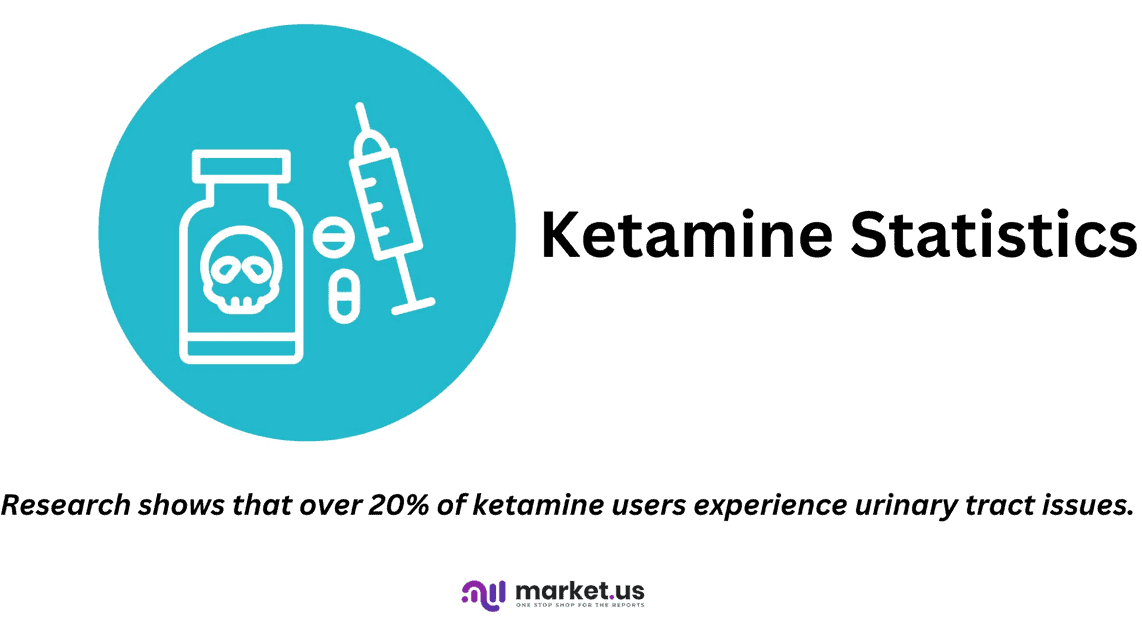
Editor’s Choice
- Ketamine, initially synthesized in 1962 and known by its chemical name, Cl-581, was developed as a dissociative anesthetic.
- Ketamine acts quickly once taken—it kicks in within a minute when injected, 5 to 15 minutes when snorted, and about 30 minutes if ingested.
- As of 2015, the lifetime prevalence of ketamine use varies significantly across selected countries. The United Kingdom has the highest recorded prevalence among the listed countries at 2.6%.
- Moreover, from 2000 to 2021, various clinical trials globally have investigated the use of ketamine as a medicine across different conditions and trial phases. For depression, including major depressive disorder (MDD), treatment-resistant depression (TRD), and bipolar disorder. There have been 48 trials in Phase 1, 38 in Phase 2, 15 in Phase 3, and 29 in Phase 4.
- Further, In 2015, a survey among partygoers in Flanders, Belgium, examined the frequency of ketamine use. The results indicated that a majority, 85.3%, reported they had never used ketamine.
- Ketamine abuse is mainly seen in the U.S. among young people aged 16 to 25, but the typical user is often a man around 31 years old.
- In Great Britain in 2015, public opinion on the safety of using ketamine showed that most people viewed it as risky. A significant majority, 67%, regarded it as very dangerous.

Anesthesia Drugs Market Overview
Global Anesthesia Drugs Market Size
- The global anesthesia drugs market is projected to witness steady growth from 2023 to 2033 at a CAGR of 3.3%.
- In 2023, the market is expected to generate revenue of approximately USD 6.8 billion, and this figure is anticipated to increase to USD 7.0 billion by 2024.
- By 2025, the market is forecast to reach USD 7.3 billion. Followed by further growth to USD 7.5 billion in 2026 and USD 7.7 billion in 2027.
- The upward trend is expected to continue, with market revenues projected to rise to USD 8.0 billion in 2028 and USD 8.3 billion in 2029.
- By 2030, the market is forecast to generate USD 8.5 billion in revenue, with further increases to USD 8.8 billion in 2031 and USD 9.1 billion in 2032.
- By 2033, the market is expected to reach approximately USD 9.4 billion, reflecting sustained growth over the forecast period.
(Source: market.us)
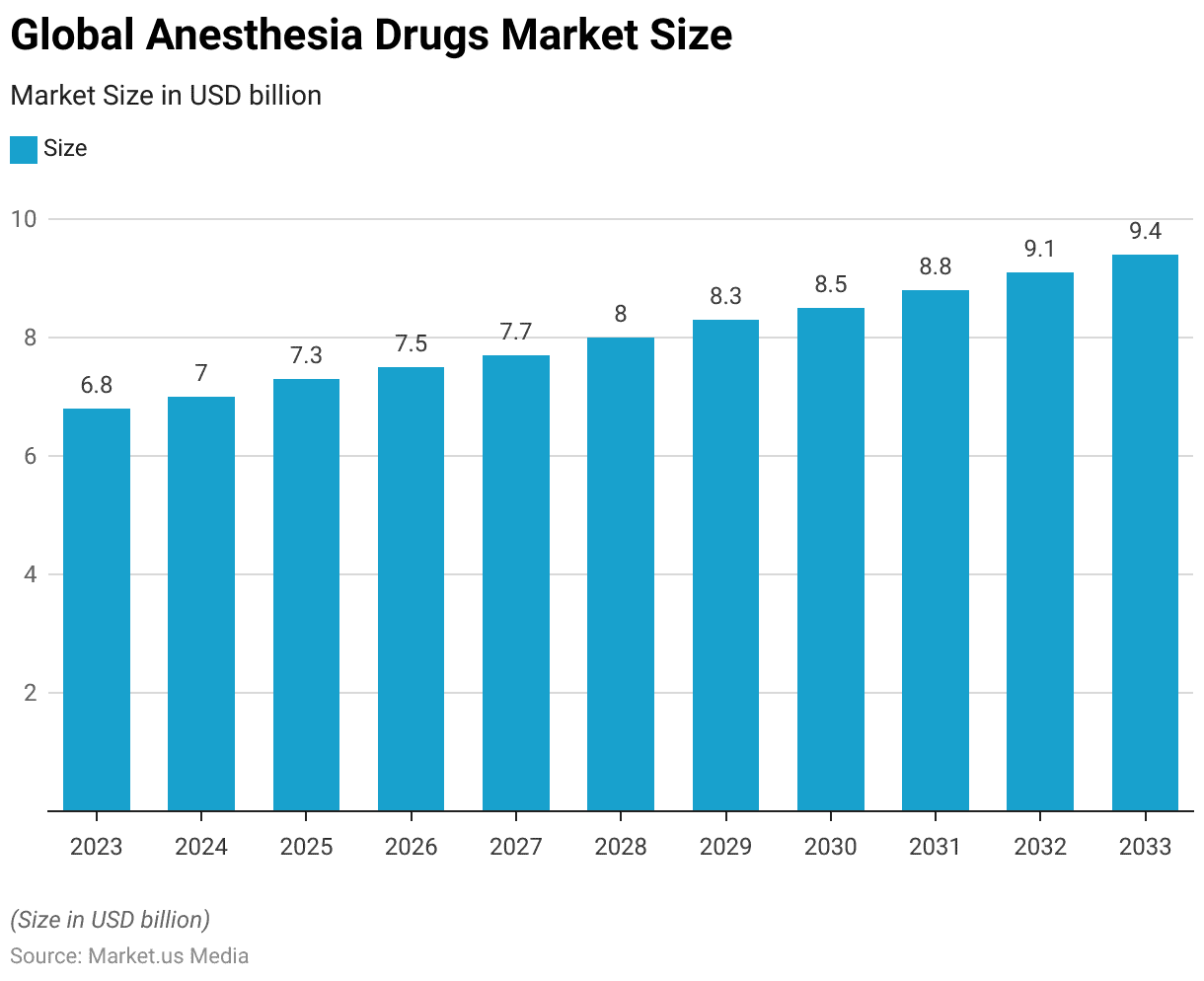
Global Anesthesia Drugs Market Size – By Type
- The global anesthesia drugs market is forecasted to exhibit sustained growth from 2023 to 2033. Segmented into general and local anesthesia drugs.
- In 2023, total market revenue stands at USD 6.8 billion. Split between general anesthesia drugs at USD 4.48 billion and local anesthesia drugs at USD 2.32 billion.
- This pattern of growth persists, with the market projected to expand to USD 7.0 billion in 2024, USD 7.3 billion in 2025, and further to USD 7.5 billion in 2026.
- By 2027, revenues are expected to reach USD 7.7 billion. Followed by an increase to USD 8.0 billion in 2028 and USD 8.3 billion in 2029.
- The market is anticipated to grow to USD 8.5 billion by 2030, USD 8.8 billion by 2031, and USD 9.1 billion by 2032.
- By 2033, it is forecasted to achieve USD 9.4 billion. Throughout this period, revenues from general anesthesia drugs are expected to increase from USD 4.48 billion in 2023 to USD 6.19 billion in 2033. While local anesthesia drugs are projected to grow from USD 2.32 billion to USD 3.21 billion.
- This reflects a consistent growth trajectory in both segments of the market.
(Source: market.us)

Antidepressants Drugs Market Overview
Global Antidepressants Drugs Market Size
- The global antidepressant drugs market is poised for progressive growth over the decade from 2023 to 2033 at a CAGR of 7.5%.
- Starting with a revenue of USD 13.8 billion in 2023. The market is expected to escalate to USD 16 billion in 2024.
- The following years see a steady rise, with the market reaching USD 17 billion in 2025, USD 18 billion in 2026, and USD 20 billion by 2027.
- The upward trajectory continues, with the revenue hitting USD 21 billion in 2028, USD 23 billion in 2029, and further expanding to USD 25 billion by 2030.
- In the subsequent years, the market is forecasted to grow to USD 26 billion in 2031, USD 28 billion in 2032, and culminating at USD 30.5 billion by 2033.
- This consistent increase underscores a robust growth pattern in the global antidepressant drugs market over the projected period.
(Source: market.us)
Take advantage of our unbeatable offer - buy now!

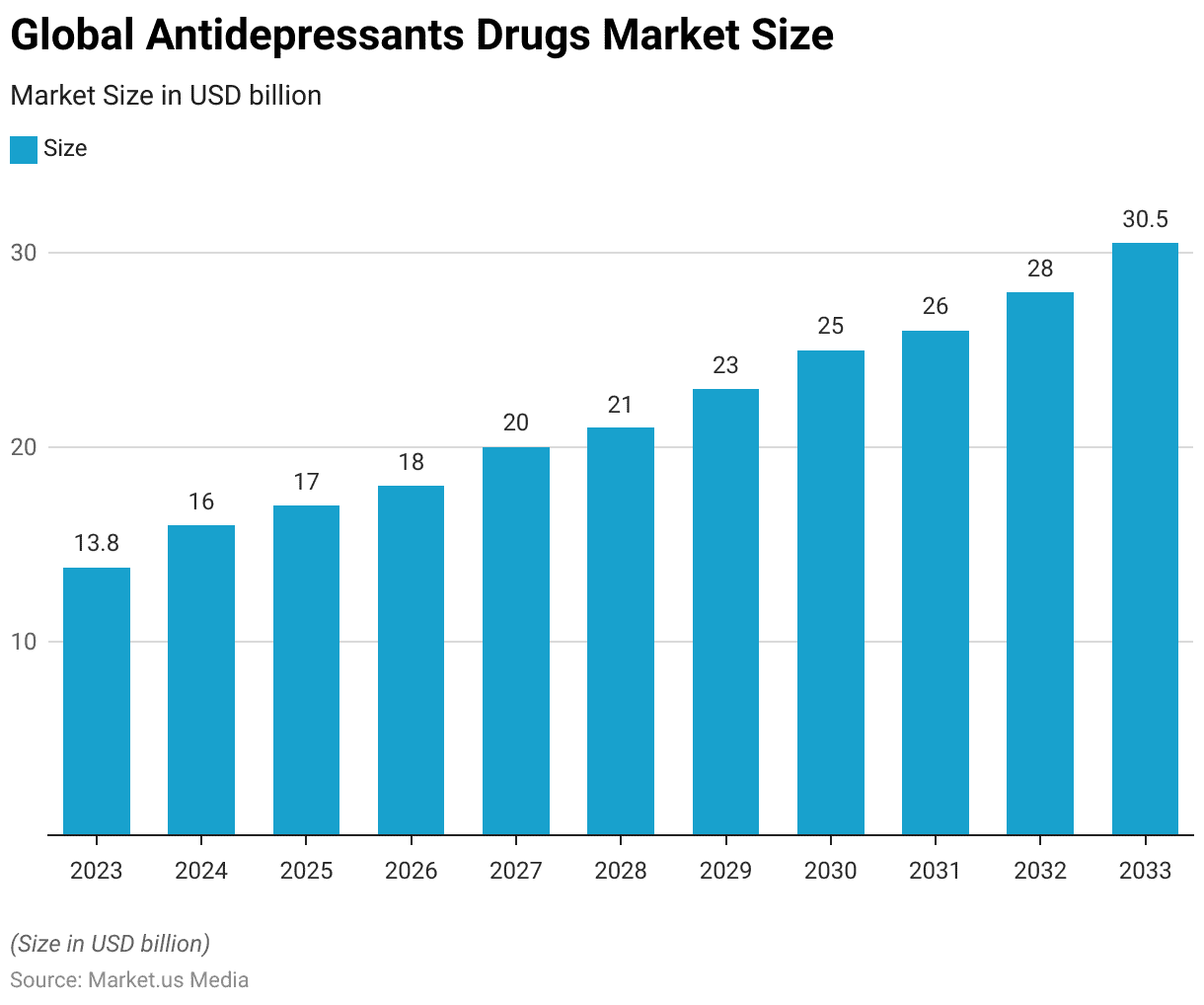
Global Antidepressants Drugs Market Share – By Distribution Channel
- In the global antidepressant drugs market, the distribution channel shares demonstrate a significant lean towards offline sales, which constitute 84.5% of the market.
- Online sales, while smaller, still account for a notable 15.5% of the market share.
- This distribution pattern indicates a strong preference for traditional purchasing methods in the antidepressant drugs sector. Although a non-negligible portion of the market is captured through digital platforms.
(Source: market.us)
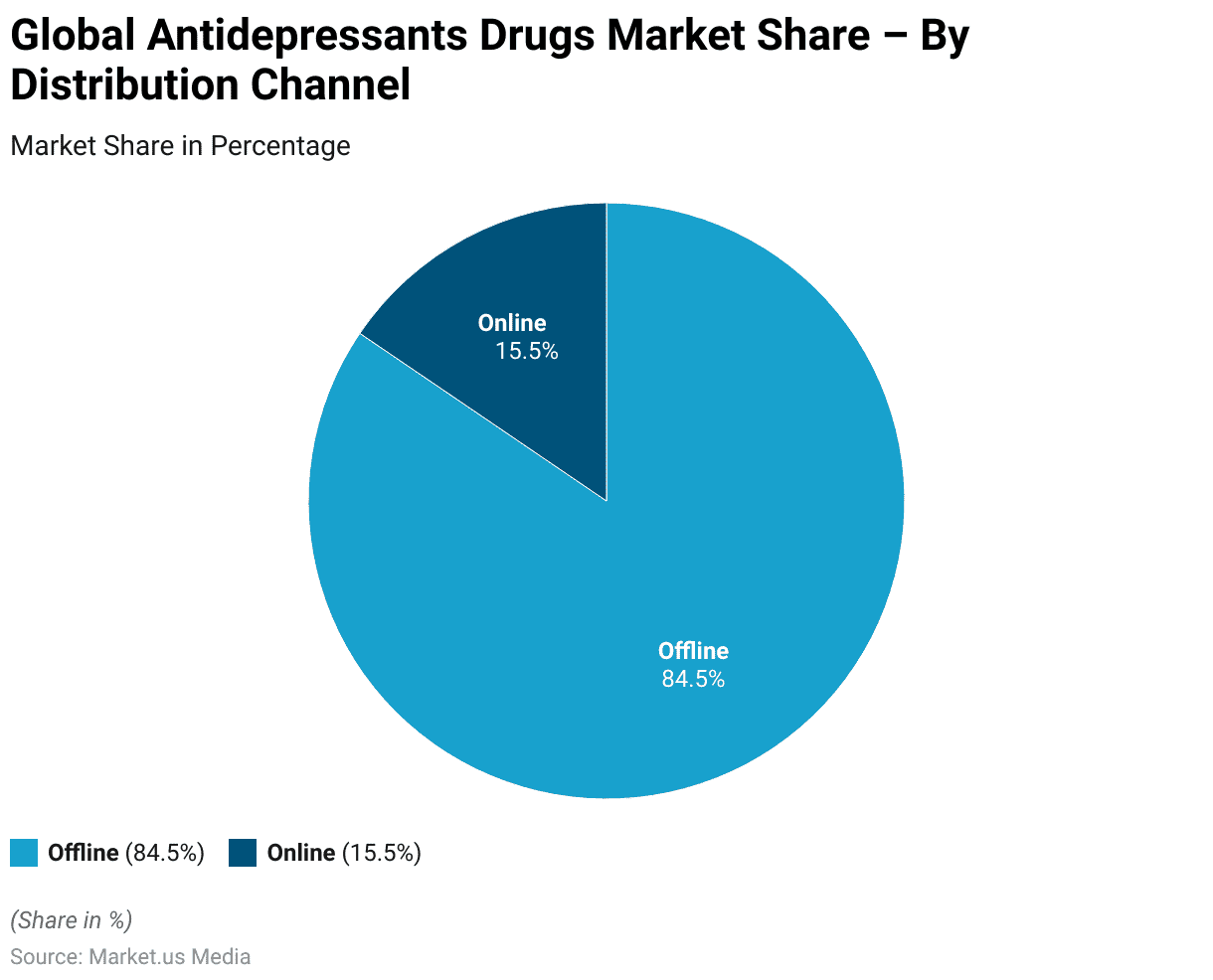
History of Ketamine Use
- Ketamine, initially synthesized in 1962 and known by its chemical name, Cl-581, was developed as a dissociative anesthetic.
- The first human tests occurred in 1964 with prison volunteers in Michigan. Highlighting its safety compared to previous anesthetics like phencyclidine (PCP).
- By 1970, the FDA approved Ketamine-HCL under the trade name Ketalar®.
- Its medical use escalated during the Vietnam War, earning the nickname “buddy drug” because soldiers could administer it to each other for immediate pain relief without respiratory risks.
- However, its potential for abuse was recognized by the late 1970s as it became popular in the club scene for its dissociative effects.
- Despite its controversial recreational use, ketamine has also been pivotal in psychotherapy, with its antidepressant properties gaining scientific backing in the early 2000s.
- Today, over 300 clinical trials have explored its benefits in treating various mental health conditions. With ongoing research to refine Ketamine Assisted Psychotherapy.
(Sources: Ketamine.Com, Psychedelics Study at UC Berkeley, Ketamine Therapy Clinic Austin)
Timeline of Ketamine Statistics
1950s-1990s
- The timeline of ketamine, particularly focusing on its implications in treating depression, marks significant milestones spanning over several decades.
- Originally synthesized in 1956 as phencyclidine, ketamine itself was first created in 1962.
- It was quickly found to have clinical use by 1964, as noted by researcher E. Domino, and was notably utilized during the Vietnam War.
- The U.S. Food and Drug Administration (FDA) officially approved ketamine in 1970.
- Over the years, its significance in medicine was further recognized when it was listed on the WHO List of Essential Medicines in 1985.
- The 1990s brought critical developments, including the identification of Olney lesions in 1989. Which highlighted the potential risks of NMDA receptor antagonist drugs.
- Research by Trullas and Skolnick in 1990 underscored the antidepressant actions of drugs functioning as antagonists at the NMDA receptor.
- Ketamine was classified as a Class III non-narcotic in 1999.
2000s and Forward
- The new millennium saw several key evaluations of ketamine by the WHO Expert Committee on Drug Dependence (ECDD) in 2006, 2012, and 2014, assessing its risks versus benefits.
- The antidepressant potential of ketamine was first reported in 2006 by Berman et al., with further evidence of its efficacy replicated by Zarate et al. in 2017.
- In 2019 and 2020, the FDA approved Spravato® (ketamine), a derivative of ketamine. For treatment-resistant depression (TRD) and major depressive disorder with suicidal ideation (MDSI).
- More recently, the American Psychiatric Association (APA) reached a consensus on ketamine’s use for major depressive disorder (MDD) in 2023.
- Additionally, PCORI’s ELKET*D results were published by Anand et al. in 2023, indicating ongoing research and validation of ketamine’s antidepressant efficacy. Including promising results in rodent studies regarding R-ketamine and RR-HNK.
- This historical timeline illustrates ketamine’s evolving role from an anesthetic to a pivotal antidepressant therapy. Marking its progress and ongoing potential in medical science.
(Source: Reagan-Udall Foundation)
Ketamine Chemical and Physical Properties Statistics
- Ketamine, a well-known anesthetic, possesses specific chemical and physical properties crucial for its pharmacological profile.
- It has a molecular weight of 274.18 g/mol and an exact mass identical to its monoisotopic mass at 273.0687196 g/mol.
- The molecule includes two hydrogen bond donors and two hydrogen bond acceptors, reflecting its potential for interaction in biological systems.
- Additionally, ketamine features two rotatable bonds, which contribute to its flexibility.
- The topological polar surface area, a measure of the molecule’s polarity, is noted at 29.1Ų, and it contains a total of 17 heavy atoms, which indicates its complexity, calculated to be 269.
- Ketamine carries no formal charge and comprises two covalently bonded units.
- Moreover, the stereochemistry of ketamine is defined by the presence of one undefined atom stereocenter, with no defined or undefined bond stereocenters, underscoring its structural attributes significant for medicinal application.
(Source: PubChem)
Ketamine Formulation Properties Statistics
- Route of Administration
- When given through an IV, the starting dose of Ketamine Hydrochloride Injection can vary between 1 mg/kg and 4.5 mg/kg.
- Typically, a dose of 2 mg/kg is enough to keep a person anesthetized for surgery for about 5 to 10 minutes, starting just 30 seconds after injection.
- It’s important to inject ketamine slowly, over a minute, to avoid breathing problems and a strong blood pressure response.
- This dose can also be given more gradually as an IV infusion at a rate of 0.5 mg/kg per minute.
- When injected into a muscle, the starting dose of Ketamine Hydrochloride Injection ranges from 6.5 mg/kg to 13 mg/kg.
- A dose between 9 mg/kg and 13 mg/kg generally starts working within 3 to 4 minutes, and the anesthesia lasts between 12 and 25 minutes.
(Source: National Institute of Health)
Dosage Forms and Strength
- Ketamine Hydrochloride Injection is a clear, colorless, slightly yellowish sterile solution that comes in multiple-dose vials.
- These vials are available in two strengths based on the ketamine base content: one with 50 mg of ketamine base. Equivalent to 57.67 mg of ketamine hydrochloride, and another with 100 mg of ketamine base, equivalent to 115.34 mg of ketamine hydrochloride.
- The product is packaged in different concentrations, including a 500 mg/10 mL solution. Which provides 50 mg/mL, and a more concentrated 500 mg/5 mL solution, delivering 100 mg/mL.
(Source: National Institute of Health)
Pharmacological Properties
- Ketamine hydrochloride has been extensively evaluated across 105 separate studies in New Zealand. Involving more than 10,000 patients and over 12,000 operative and diagnostic procedures.
- During these studies, ketamine was used alone as an induction agent for other general anesthetics or to enhance the effects of low-potency agents.
- The anesthesia quality was highly rated, with 90% and 93% of cases deemed “excellent” or “good” by anesthetists and surgeons, respectively. Additionally, in another evaluation method. The anesthesia was considered “adequate” in at least 90% of the cases and “inadequate” in 10% or fewer.
- Ketamine is quickly absorbed after injection, achieving peak plasma levels of approximately 0.75 µg/mL and cerebrospinal fluid levels of about 0.2 µg/mL within an hour. It has a plasma half-life ranging from 2 to 4 hours.
- Following an intravenous bolus, ketamine exhibits a bi- or triexponential elimination pattern, with the initial phase lasting about 45 minutes and a half-life of 10 to 15 minutes.
- This phase represents the anesthetic action of ketamine. Ending as the drug redistributes from the central nervous system to peripheral tissues and undergoes hepatic transformation into an active metabolite. The subsequent beta phase has a half-life of about 2.5 hours.
- Approximately 90% of administered ketamine is excreted in the urine. Predominantly as metabolites only about 2 to 4% remains unchanged. Around 5% is found in the feces, and the renal clearance of ketamine hydrochloride is about 15 ± 5 mL/min/kg.
(Source: Medsafe)
Effects of Ketamine Statistics
- Ketamine acts quickly once taken—it kicks in within a minute when injected, 5 to 15 minutes when snorted, and about 30 minutes if ingested.
- The duration of ketamine’s effects is shorter than PCP, typically lasting only 30 to 60 minutes.
- Long-term or frequent use of ketamine can lead to serious mental health issues, including depression, memory problems, and difficulty concentrating.
- It can also cause a severe bladder condition known as ulcerative cystitis. Which results in pelvic pain, frequent urination, blood in the urine, and incontinence.
- Research shows that over 20% of ketamine users experience urinary tract issues.
- While death from a ketamine overdose alone is rare due to its tendency to cause unconsciousness without significantly affecting breathing or heart function, it remains a risky substance.
(Source: Legislative Analysis and Public Policy Association)
Consumption of Antidepressants
- In 2022, the consumption of antidepressants across various countries. Measured in Defined Daily Doses (DDD) per 1,000 inhabitants, highlighted significant variance.
- Iceland topped the list with 157.3 DDD, closely followed by Portugal at 150.5 DDD and the United Kingdom with 138.2 DDD.
- Canada also showed high consumption at 134 DDD.
- Other countries with notable antidepressant usage included Australia (127.9 DDD), Sweden (114.5 DDD), and Spain (98.4 DDD).
- New Zealand and Chile reported consumption rates of 96 DDD and 94.3 DDD, respectively.
- In the mid-range, Belgium had an 86.2 DDD consumption, Finland 85.2 DDD, and Denmark 84.6 DDD.
- Greece, Czechia, and Slovenia showed lower yet significant usage at 73.1 DDD, 69.4 DDD, and 68.4 DDD, respectively.
- Among other countries, Germany recorded 64 DDD, Austria 63.5 DDD, and Norway 63.1 DDD.
- At the lower end of the scale, countries like Israel, France, and Luxembourg had 61.8, 57.6, and 53.1 DDD respectively.
- Turkey and the Netherlands had consumption levels of 52.5 DDD and 48.5 DDD.
- The lowest usage was observed in Latvia, with only 24.3 DDD.
- This data underscores the varying reliance on antidepressant medications across these countries in 2022.
(Source: Statista)

Lifetime Prevalence of Ketamine Use Statistics
- As of 2015, the lifetime prevalence of ketamine use varies significantly across selected countries.
- In Argentina, the prevalence stands at 0.3%, while Australia reports a higher rate of 1.7%.
- Canada has a prevalence of 1.4%.
- Colombia shows a notably lower prevalence at just 0.18%.
- In Europe, Germany and Spain both have a prevalence rate of 0.8%.
- New Zealand’s prevalence is slightly higher at 1.2%.
- Thailand reports a prevalence of 0.7%.
- The United Kingdom has the highest recorded prevalence among the listed countries at 2.6%.
- Lastly, Uruguay has a prevalence of 0.6%.
- These statistics reflect the varied extent of ketamine use across these diverse regions.
(Source: Statista)
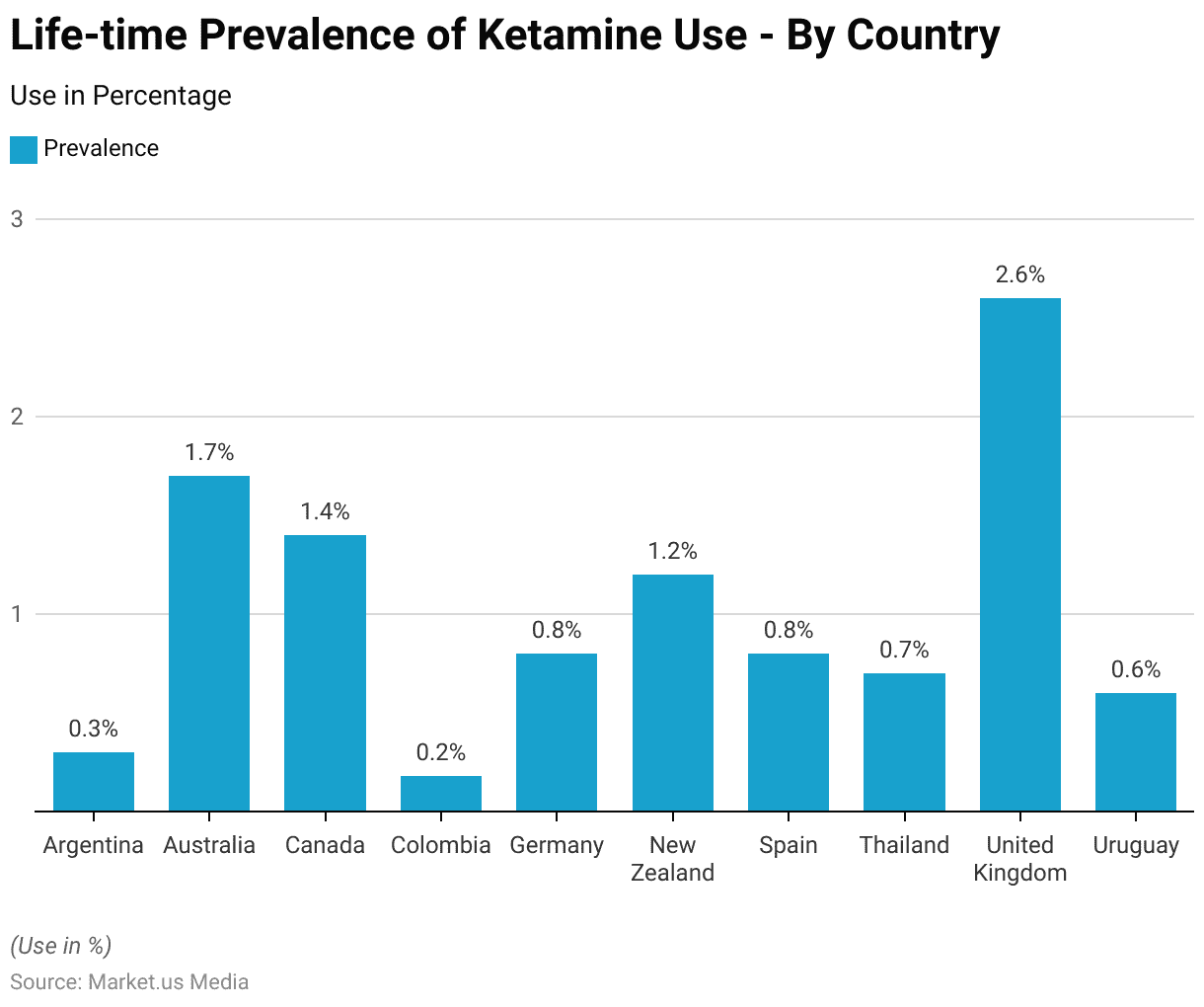
Clinical Trials Using Ketamine as Medicine Worldwide Statistics
- From 2000 to 2021, various clinical trials globally have investigated the use of ketamine as a medicine across different conditions and trial phases.
- For depression, including major depressive disorder (MDD), treatment-resistant depression (TRD), and bipolar disorder, there have been 48 trials in Phase 1, 38 in Phase 2, 15 in Phase 3, and 29 in Phase 4.
- Trials focusing on suicidal ideation involved 5 in Phase 1, 1 in Phase 2, 3 in Phase 3, and 1 in Phase 4.
- Anxiety was the subject of only one trial each in Phase 1 and Phase 2.
- Substance use disorder was studied in 2 trials each for Phase 1, Phase 2, and Phase 3.
- Post-traumatic stress disorder (PTSD) was examined in 1 Phase 1 trial, 2 in Phase 2, and 1 in Phase 4.
- This distribution of trials highlights the varied research interest in ketamine’s potential across multiple psychiatric and psychological conditions.
(Source: Statista)

Ketamine Use Among Partygoers Statistics
- In 2015, a survey among partygoers in Flanders, Belgium, examined the frequency of ketamine use.
- The results indicated that a majority, 85.3%, reported they had never used ketamine.
- A smaller fraction, 9.8%, mentioned they had used ketamine previously but not within the past year.
- Regular use was relatively low, with 3.1% of respondents using it once a month or less.
- Even fewer, 0.7%, used it multiple times a month, and 0.9% used it once a week.
- A very small minority reported more frequent use, with 0.1% using ketamine multiple times a week and another 0.1% using it daily.
- This data highlights that while ketamine use was not widespread among the partygoers in Flanders. A small percentage did engage in its use at varying frequencies.
(Source: Statista)
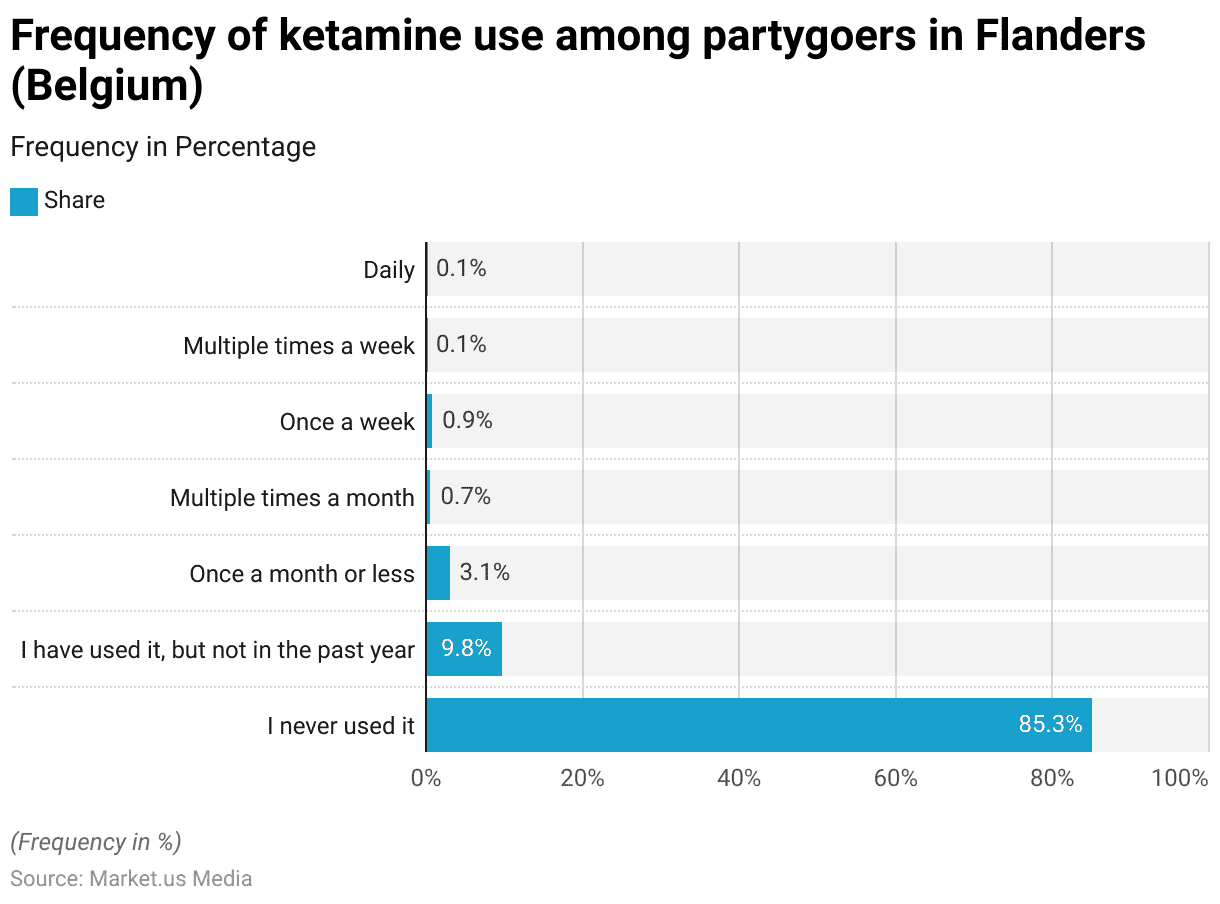
Ketamine Use Among Nightclub Attendees Statistics
- Among nightclub attendees in New York City, ketamine use varies by recency and detection method.
- A survey shows that 14.5% of respondents reported using ketamine within the past month, while 8% reported using it within the past day.
- Additionally, 12.2% of the attendees tested positive for ketamine in saliva tests.
- This data indicates a notable presence of ketamine use among this group, highlighting different levels of recent usage detected through self-reporting and biochemical testing.
(Source: Reagan-Udall Foundation)

Abuse of Ketamine Statistics
- Ketamine abuse is mainly seen in the U.S. among young people aged 16 to 25, but the typical user is often a man around 31 years old.
- Unfortunately, ketamine is also sometimes used as a date rape drug because it can cause sedation and make people forget what happened.
- In 2020, about 1.3% of U.S. high school seniors said they used ketamine. Some of these students tried ketamine to manage depression or to experience its effects.
- While specific data separating teen from adult use isn’t available, it’s known that less than 1% of both groups in the U.S. use ketamine for fun.
- A study found that between 2015 and 2019, over 210,000 adults in the U.S. reported using ketamine in the past year.
(Source: Addiction Help)
Ketamine Overdose Statistics
- Most of the time, when people overdose on ketamine, it’s because they’ve mixed it with other substances like alcohol or different drugs.
- An overdose can happen if someone takes too much ketamine alone or mixes it with these other substances.
- In 2011, there were over 1,500 emergency room visits in the U.S. because of ketamine, and about 70% of these involved mixing ketamine with alcohol.
- However, cases of ketamine poisoning, which is when there’s too much ketamine in the body, are still quite rare in the U.S.
- In 2014, for every million people, only one person went to the emergency room for ketamine poisoning.
- Over the years, fewer people are going to the emergency room because of ketamine.
- For example, in 1974, 74% of all drug-related visits to emergency departments were due to ketamine, which is a lot higher than today.
(Source: Addiction Help)
Ketamine Poisoning Statistics
Reasons for Ketamine Poisoning Statistics
- The reasons for ketamine poisonings vary, with misuse or abuse leading as the most common cause, accounting for 36.2% of incidents.
- This is followed by 21.1% of cases suspected to be suicide attempts and 19.7% resulting from unintentional exposure.
- Adverse drug reactions also contribute to ketamine poisonings, comprising 11.3% of the cases.
- Other unspecified reasons are noted in 6.8% of incidents, and 5% of poisonings are due to intentional or unknown motives.
- These statistics reflect the diverse and complex factors contributing to ketamine-related health emergencies.
(Source: Reagan-Udall Foundation)
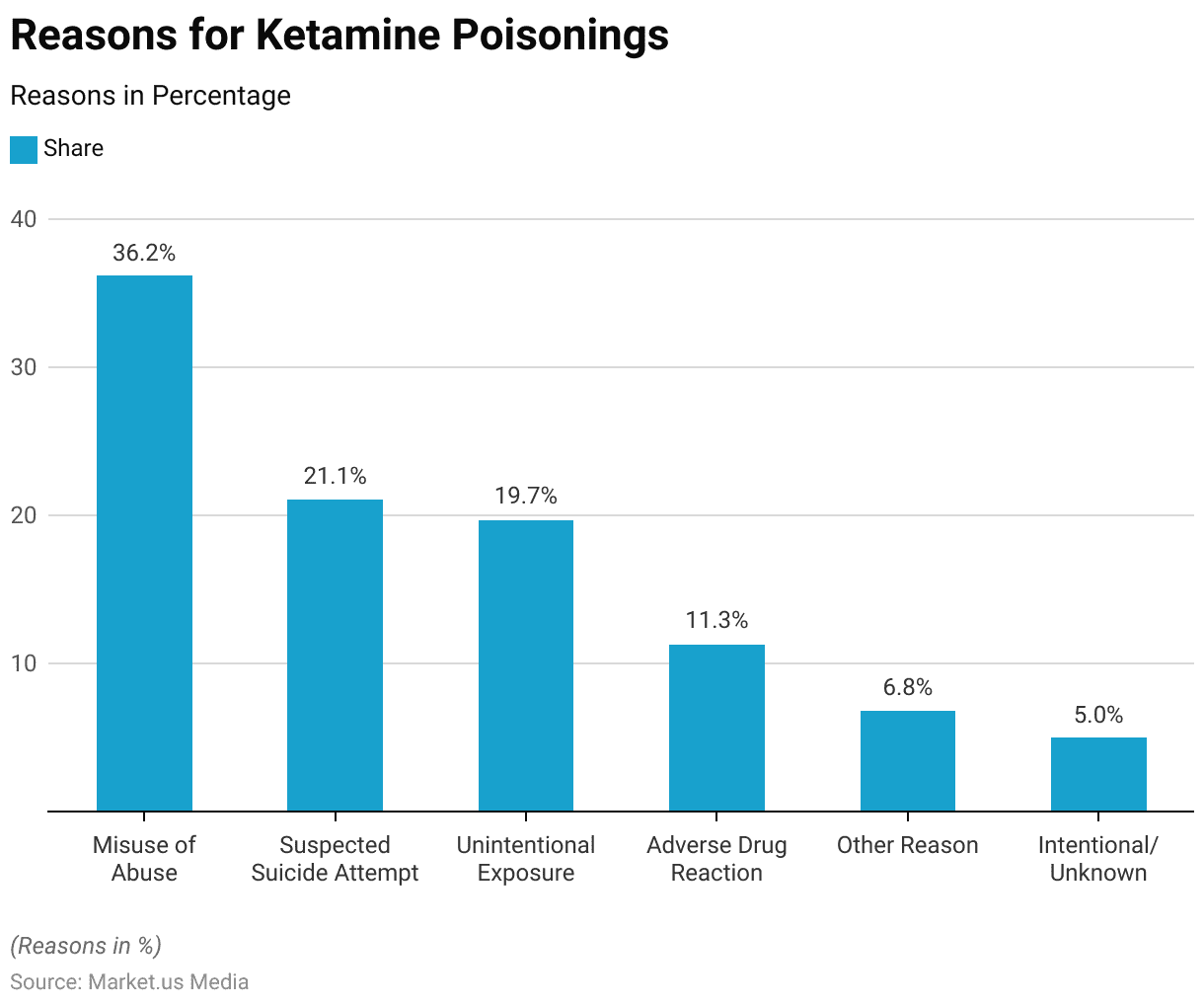
Co-drug Use Involved in Ketamine Poisoning Statistics
- In cases of ketamine poisoning, a significant portion of incidents involves the use of other drugs.
- Alcohol is the most common co-drug, reported in 14.1% of cases, followed by benzodiazepines at 11.3% and cocaine at 10.8%.
- Opioids also play a notable role, involved in 8.8% of the poisonings.
- Cannabis is implicated in 6.8% of cases, closely followed by phenethylamines at 6.4% and methamphetamine at 5.9%.
- GHB is less commonly involved, featuring in 2.9% of the incidents.
- A large category labeled ‘Other’ encompasses 41% of the cases, indicating a wide variety of other substances may also be involved in ketamine poisonings.
- This data highlights the complexity and dangers of polydrug use involving ketamine.
(Source: Reagan-Udall Foundation)
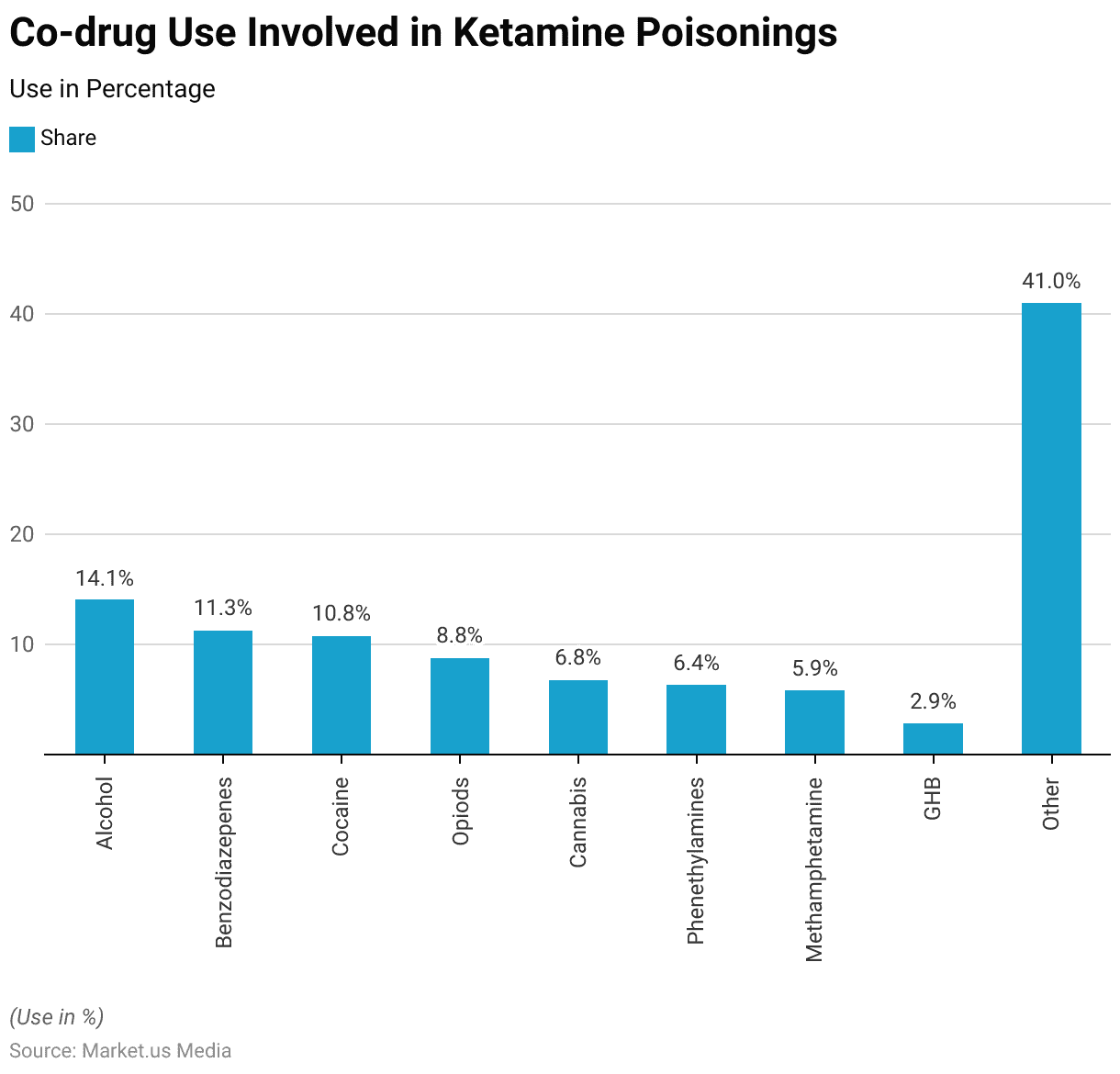
Form of Ketamine Involved in Poisoning Statistics
- In cases of ketamine poisoning, the drug was found in various forms.
- The most common form involved was liquid, accounting for 31.1% of incidents.
- Powder form was also frequently implicated, making up 22.7% of cases.
- Other less typical forms were reported as well, with ‘Other’ forms constituting 19.9% and solid forms involved in 18.5% of poisonings.
- Spray and a combination of liquid and powder were less common, noted in only 2.8% and 2.5% of cases, respectively.
- This diversity in the physical form of ketamine involved in poisonings highlights the various ways the drug can be encountered and the associated risks.
(Source: Reagan-Udall Foundation)
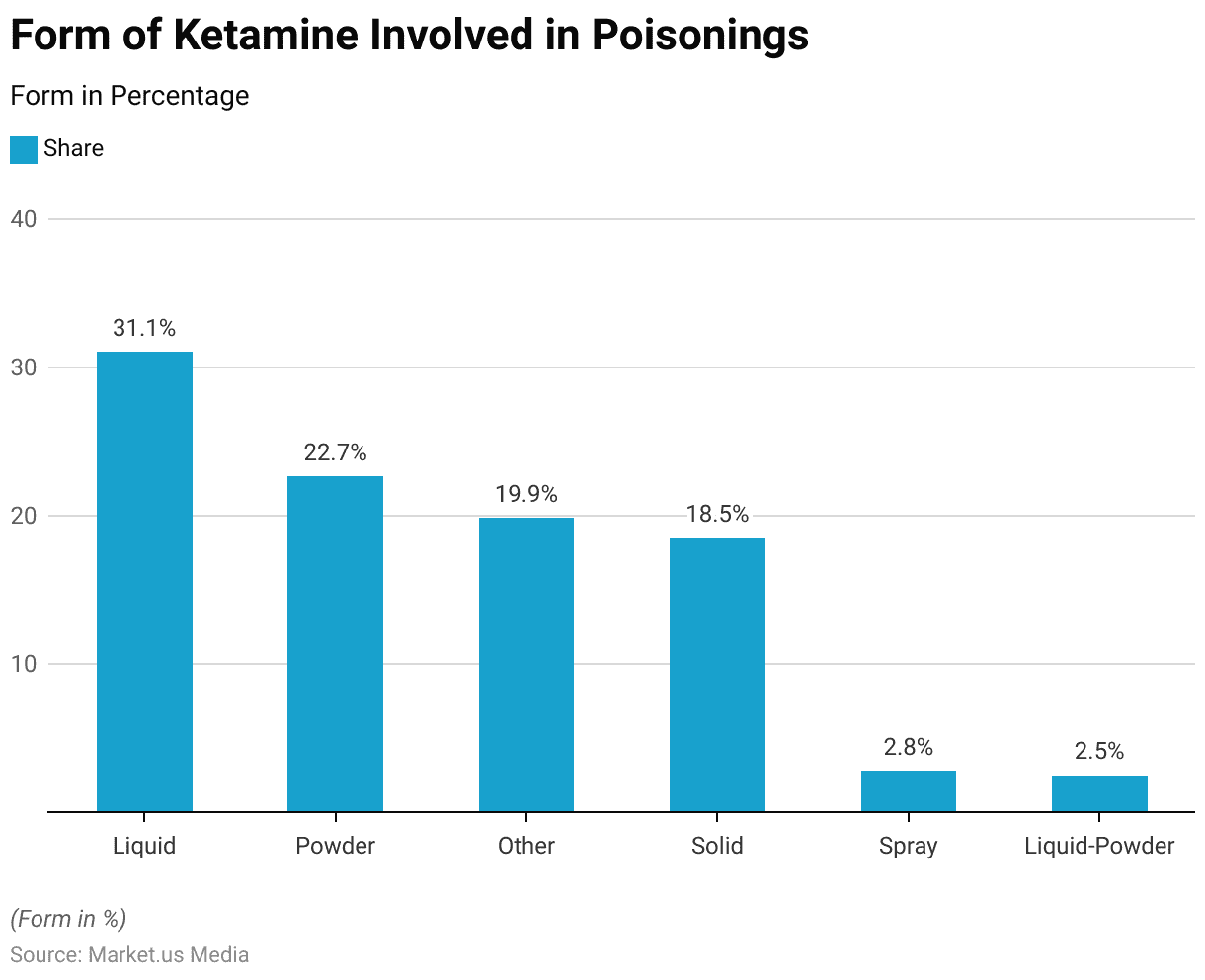
Route of Ketamine Administration in Poisoning Statistics
- In cases of ketamine poisoning, the routes of administration vary widely. Ingestion is the most common method, accounting for 62.1% of cases, indicating that many people consume ketamine orally.
- Inhalation is also a prevalent method, used in 40.5% of poisonings, showing that snorting ketamine is quite common.
- The use of multiple routes of administration, or poly-route, was reported in 17.1% of cases, highlighting instances where individuals use ketamine in more than one way. Injection is the least common route, involved in only 12.1% of poisonings.
- This diversity in administration methods reflects the different ways ketamine can be used and the associated risks with each method.
(Source: Reagan-Udall Foundation)
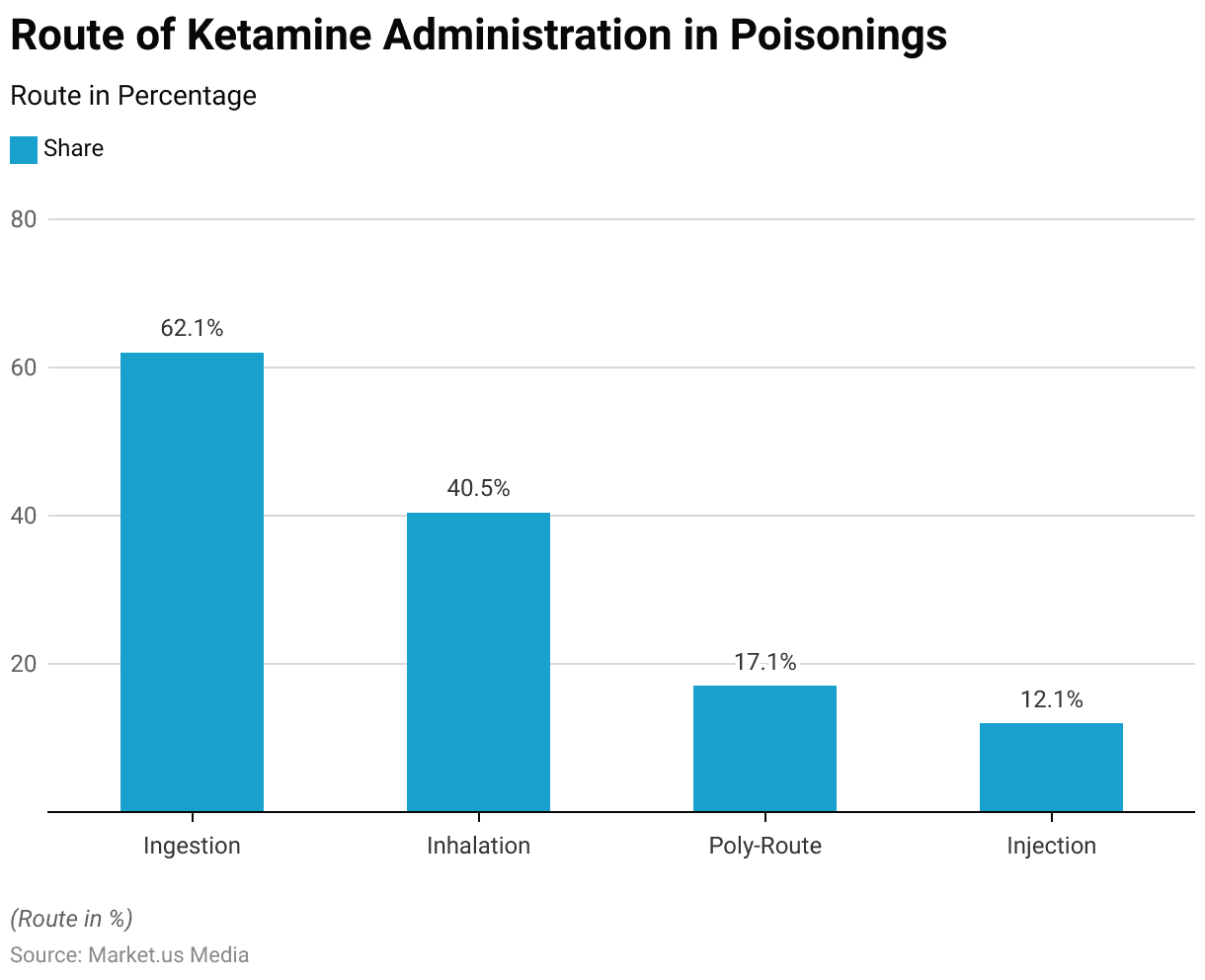
Severity of Ketamine Poisonings (Misuse/Abuse) Statistics
- In cases of ketamine poisonings related to misuse or abuse, the severity of incidents varies.
- A small percentage, 5.7%, of these poisonings result in no health impacts at all.
- Minor health effects are seen in 23.1% of cases, indicating relatively low levels of harm.
- However, the majority of ketamine poisonings, 50.5%, are classified as moderate in severity, suggesting significant but non-life-threatening effects.
- Furthermore, a substantial 20.1% of poisonings are considered major, highlighting serious health consequences.
- This distribution underscores the range of health risks associated with ketamine misuse and abuse, from negligible to severe.
(Source: Reagan-Udall Foundation)

Ketamine Seized Across Various Nations
Volume of Ketamine Seized in India Statistics
- From 2013 to 2017, the volume of ketamine seized in India varied significantly.
- In 2013, there was a particularly high amount of ketamine confiscated, totaling 1,353.02 kilograms.
- This figure dramatically decreased in 2014, when only 20.37 kilograms were seized.
- However, there was a noticeable increase in 2015, with 211.61 kilograms confiscated.
- The amount seized dropped again in 2016 to 68.06 kilograms before rising to 161 kilograms in 2017.
- This fluctuation in the volume of seized ketamine over the years highlights the varying levels of drug interception efforts and market availability in India during this period.
(Source: Statista)
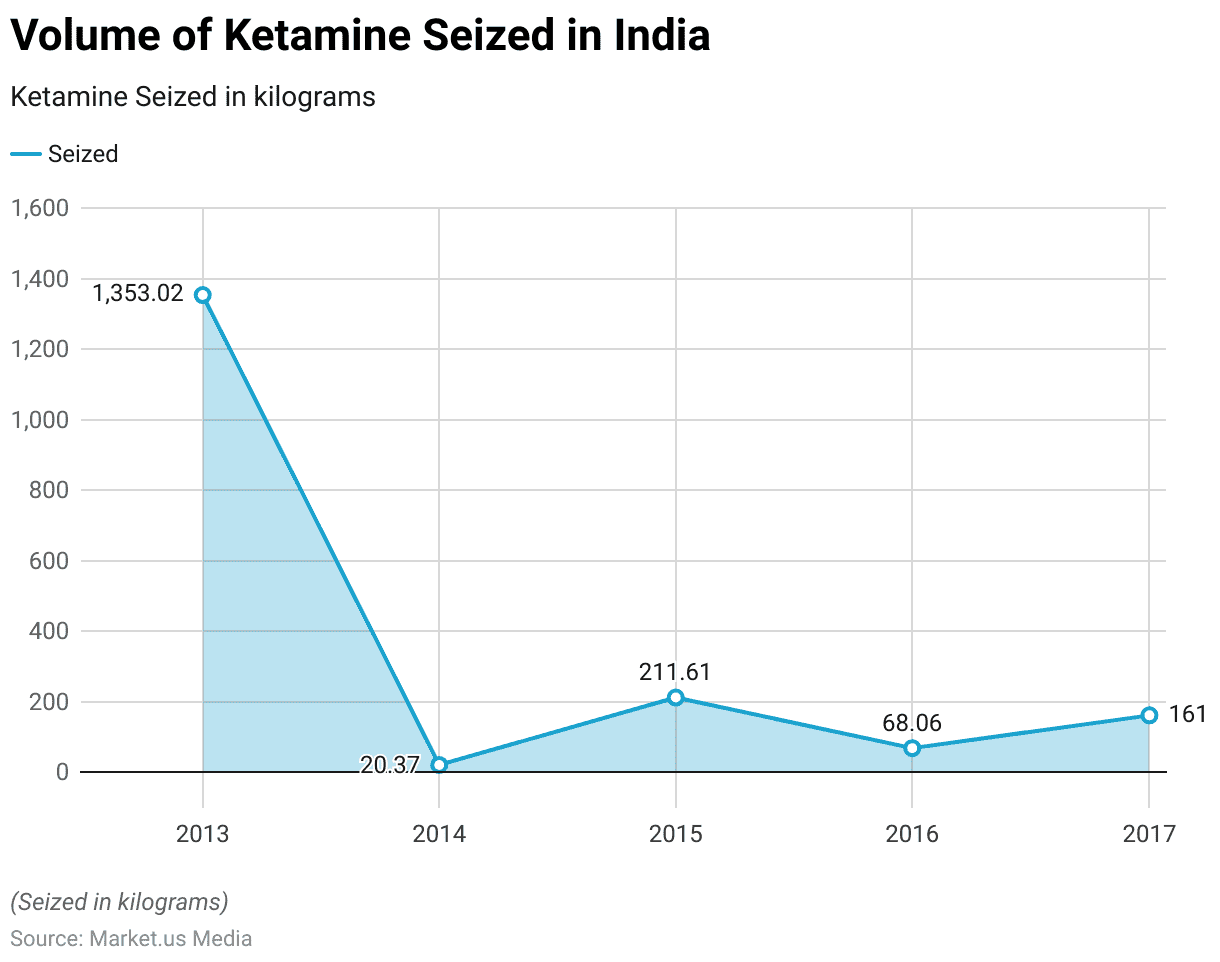
Ketamine Seized Cases in India Statistics
- Between 2013 and 2017, the number of ketamine seized cases in India showed variability.
- The year 2013 recorded the highest number of cases at 24.
- This number saw a sharp decline in 2014, with only 5 cases reported.
- However, there was a significant increase in 2015, with the count rising to 21 cases.
- The subsequent years saw a decrease again, with 7 cases in 2016 and slightly fewer, 6 cases in 2017.
- This data illustrates the fluctuating enforcement success and possibly the changing patterns in ketamine trafficking and usage over these years in India.
(Source: Statista)
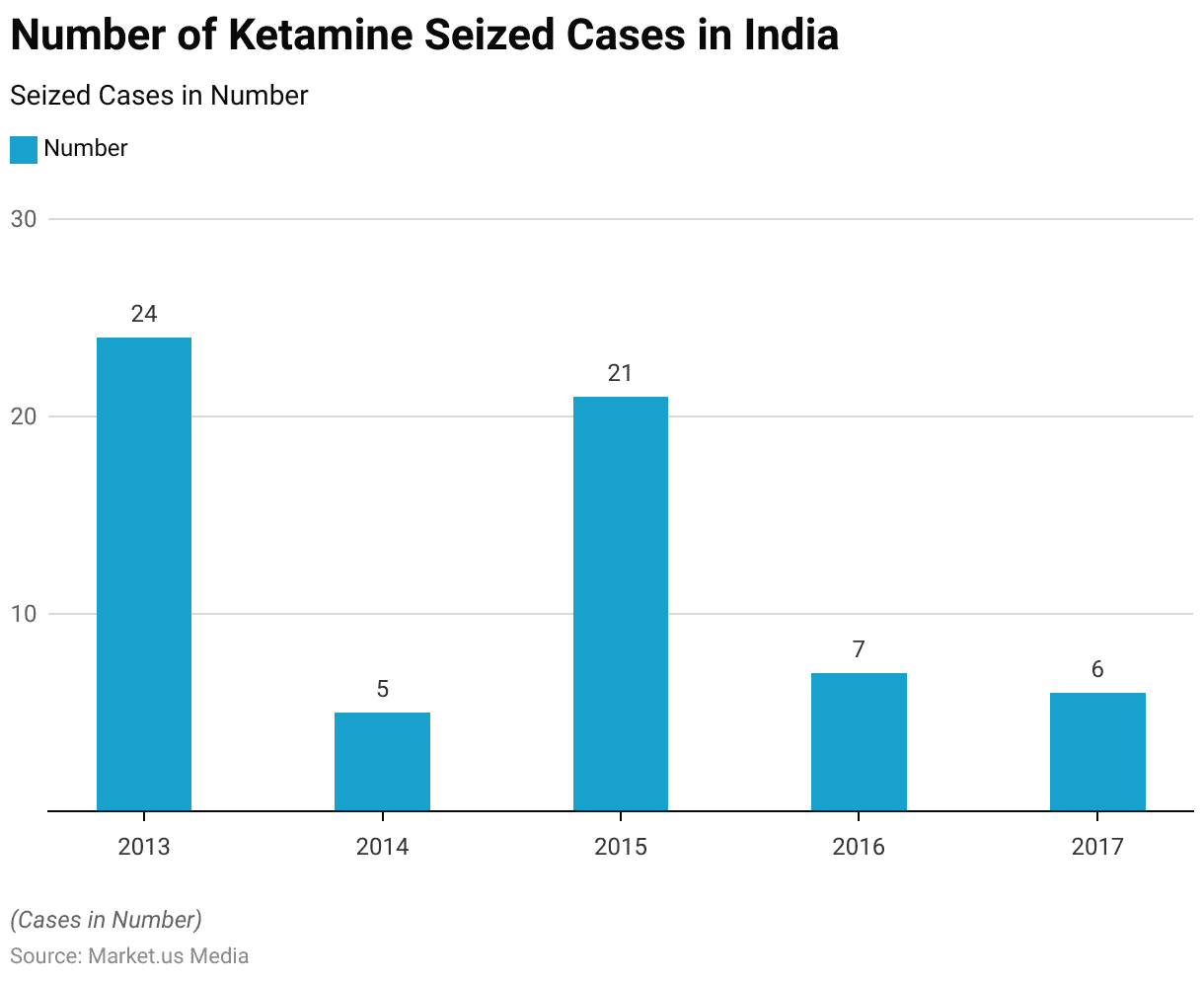
Seizing of Ketamine in China Statistics
- From 2008 to 2012, ketamine seized in China varied year by year in terms of total kilograms confiscated.
- In 2008, authorities seized a substantial 5,271.1 kilograms of ketamine.
- This figure slightly increased in 2009, reaching 5,323 kilograms.
- However, in 2010, the seized amount decreased to 4,905 kilograms.
- The seizing peaked in 2011 at 5,380 kilograms before declining again in 2012 to 4,716.6 kilograms.
- Further, this period highlighted significant efforts by Chinese law enforcement to control the distribution and availability of ketamine, with varying levels of success reflected in the annual seized volumes.
(Source: Statista)
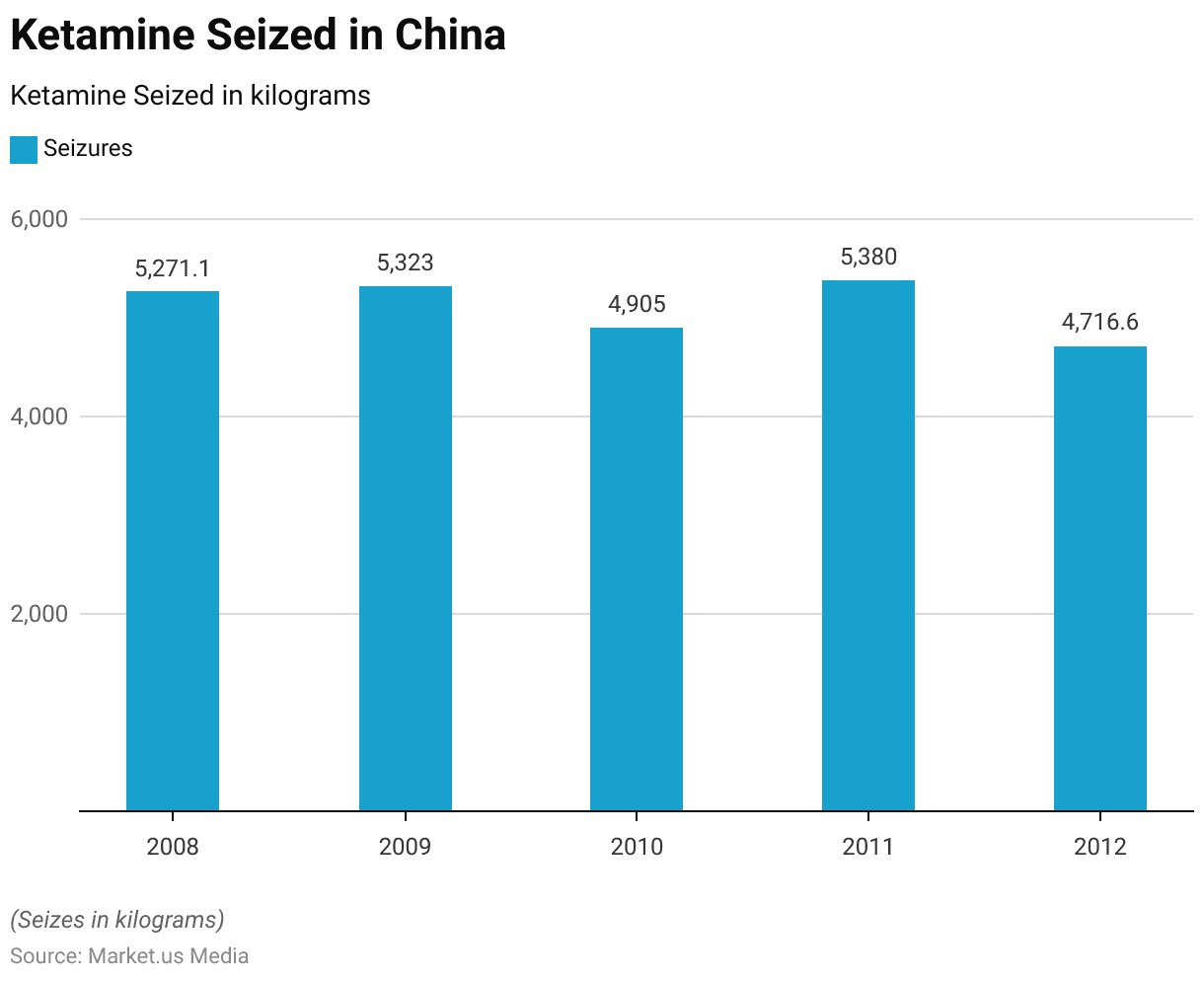
Ketamine Seized by Police Forces in England and Wales Statistics
- In the fiscal year 2017/18, police forces in England and Wales recorded various amounts of ketamine seized.
- The majority of seized were relatively small amounts: there were 346 cases involving less than 1 gram and 305 cases involving between 1 gram and 500 grams.
- Notably, no seized were recorded in the categories ranging from 1 kilogram to 10 kilograms and from 500 grams to 1 kilogram.
- However, there were 2 cases of significantly larger amounts, with seized involving between 10 kilograms and 100 kilograms.
- No seized were reported for amounts exceeding 100 kilograms.
- This data suggests that most ketamine confiscations during this period were of smaller quantities, with very few large hauls.
(Source: Statista)
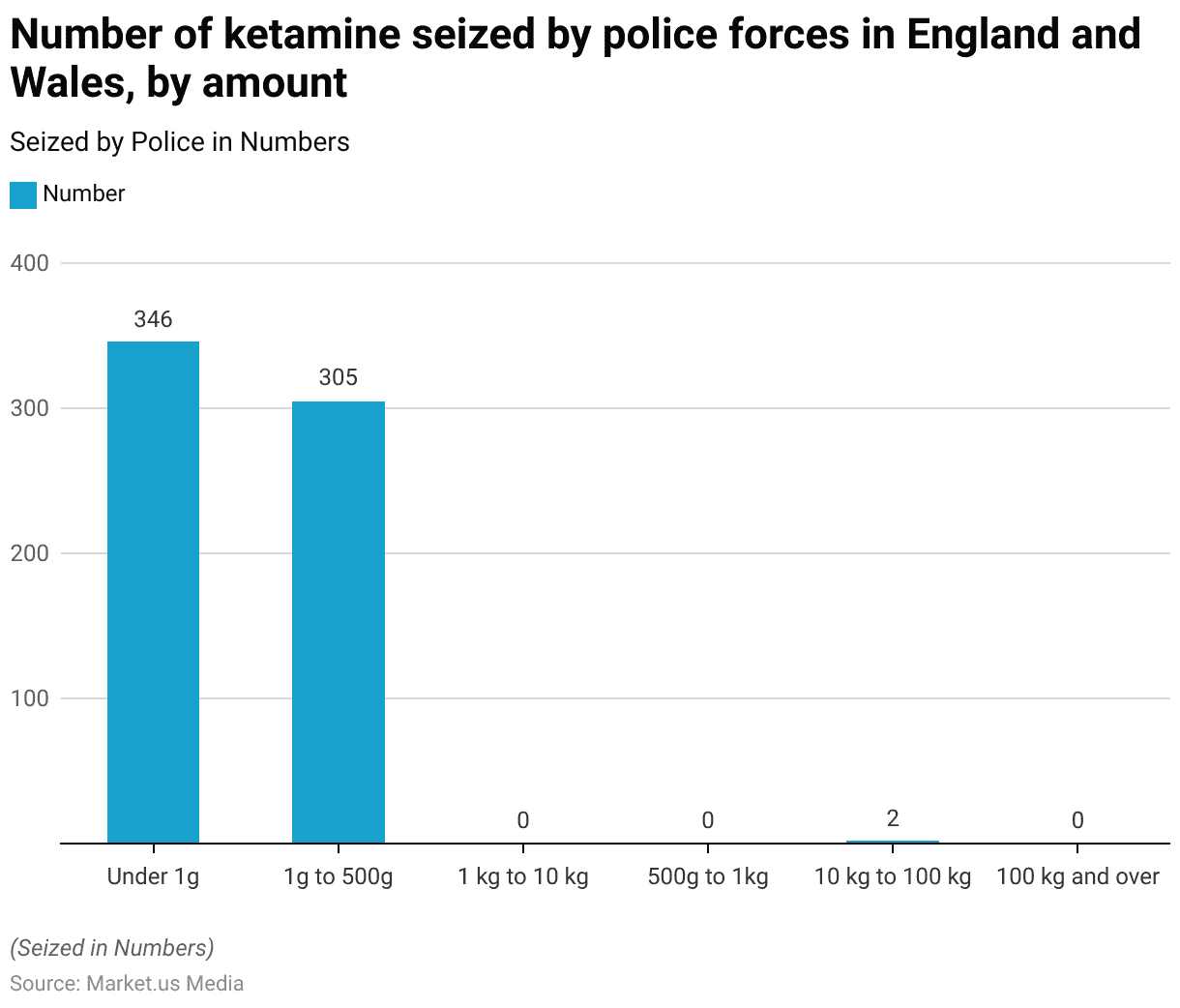
Ketamine Seized by Border Force in England and Wales Statistics
- In the fiscal year 2017/18, the Border Force in England and Wales reported a range of ketamine seized by amount.
- The data reveals that there were 2 cases involving less than 1 gram of ketamine and a more substantial number of cases, 44, involving amounts from 1 gram to 500 grams.
- There was a single case involving an amount from 500 grams to 1 kilogram.
- Notably, there were 8 seized in the range of 1 kilogram to 10 kilograms. Demonstrating a significant capture of the drug.
- Additionally, there were 2 cases involving large amounts ranging from 10 kilograms to 100 kilograms.
- No seized were reported for amounts over 100 kilograms.
- This indicates that most seized were of smaller quantities. There were several instances where the Border Force intercepted substantial amounts of ketamine.
(Source: Statista)
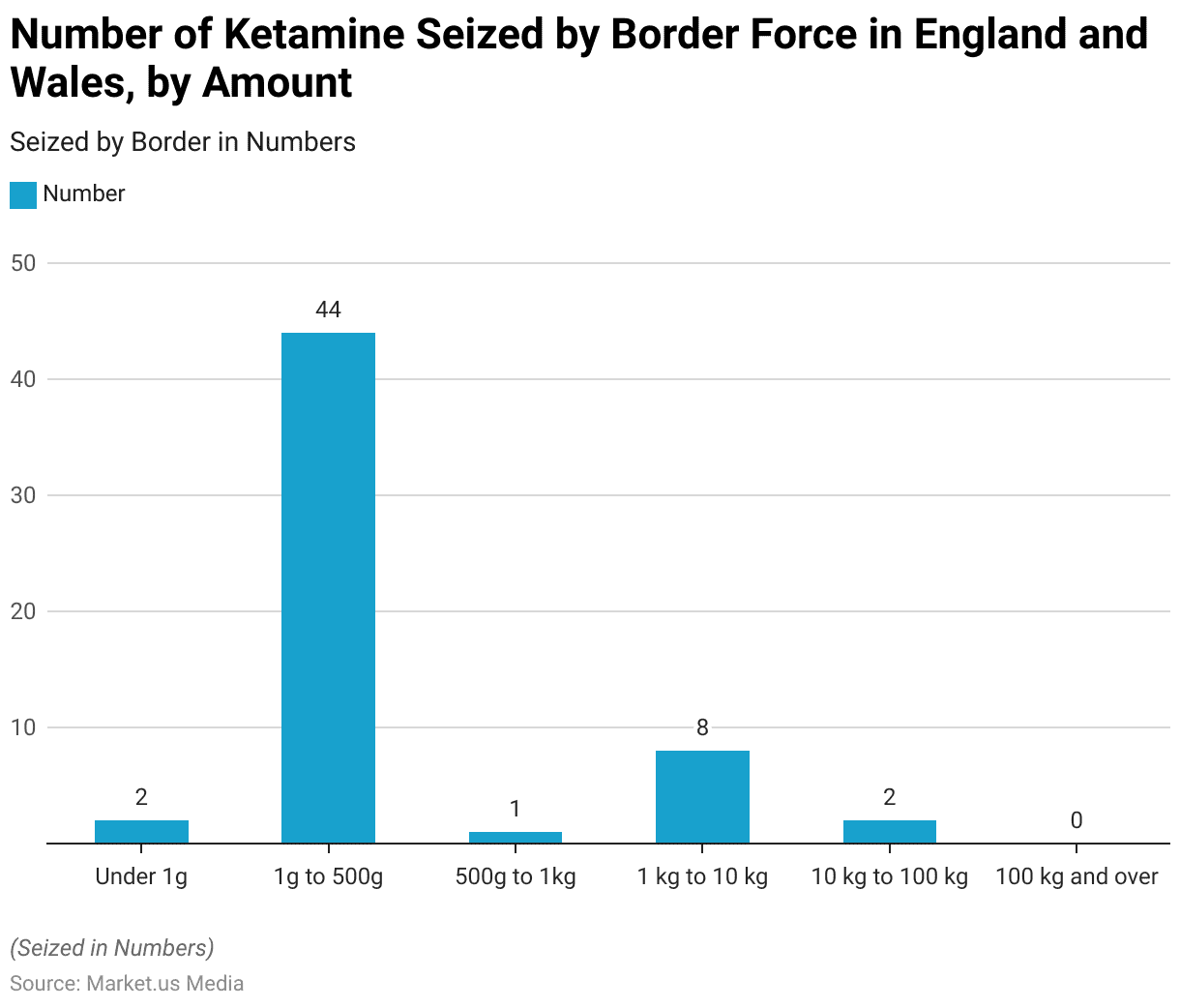
Opinion on Safe Use of Ketamine Statistics
- In Great Britain in 2015, public opinion on the safety of using ketamine showed that most people viewed it as risky.
- According to a survey, no respondents considered ketamine use to be very safe.
- Only a small fraction, 2%, believed it to be fairly safe.
- A larger segment, 16%, viewed it as fairly dangerous, while a significant majority, 67%, regarded it as very dangerous.
- Additionally, 15% of respondents were unsure about the safety of using ketamine, indicating some level of uncertainty or lack of information among the public.
- This data reflects a general perception that ketamine use poses considerable dangers.
(Source: Statista)
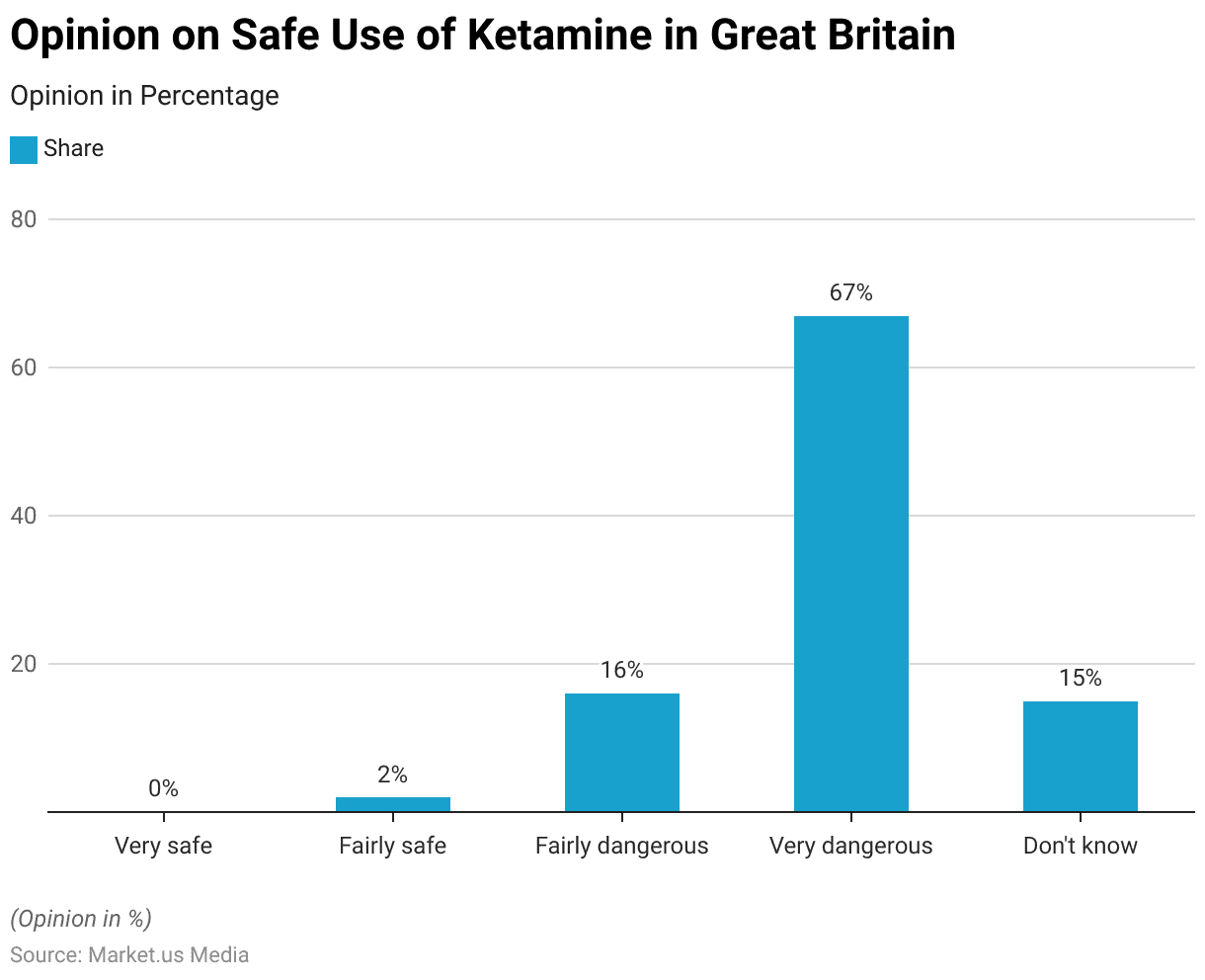
Ketamine Addiction Initiatives
- Ketamine initially used medically for anesthesia, has seen rising misuse globally. Prompting various organizations to develop targeted initiatives and programs to address addiction and facilitate recovery.
- For instance, the American Society of Ketamine Physicians, Psychotherapists & Practitioners focuses on promoting safe clinical practices and educational outreach.
- The use of ketamine, particularly in unsupervised settings, has been associated with serious health risks such as ulcerative cystitis and dependency. Leading to increased emergency room visits and health complications.
- Countries have varied responses to ketamine abuse, with some implementing stringent monitoring and educational programs to curb its recreational use.
- In the U.S., treatment programs often involve outpatient settings, allowing individuals to maintain daily responsibilities while receiving care through therapies such as Cognitive Behavioral Therapy and Motivational Enhancement Therapy. Which have shown effectiveness in dealing with ketamine and other substance dependencies.
- Moreover, Ketamine’s complexity as both a medical tool and a potential substance of abuse underscores the need for a nuanced approach that incorporates both stringent regulations and supportive therapeutic interventions to ensure its benefits are harnessed while minimizing risks.
(Source: Addiction Group, National Institute on Drug Abuse, Ketamine Physicians Society, New Start Recovery, Neurolaunch.com)
Ketamine Regulations
- Ketamine regulations vary significantly worldwide, reflecting a balance between recognizing its medical benefits and controlling its potential for abuse.
- In the United States, ketamine is classified as a Schedule III controlled substance, which permits its medical use under stringent conditions, including registration, storage, and prescription protocols governed by the DEA.
- In the UK, it’s categorized as a Class B substance under the Misuse of Drugs Act, making unauthorized production, supply, or possession illegal. However, it remains legally available for certain medical uses.
- Internationally, the legal landscape is equally diverse. Countries like China have implemented strict measures due to concerns about illegal production and trafficking, whereas, in India, ketamine continues to be widely used in both human and veterinary medicine.
- The World Health Organization has repeatedly advised against placing ketamine under the strictest control schedules globally to maintain access to essential medical procedures, especially in low-income countries.
- These varying degrees of regulation reflect the dual nature of ketamine: as a valuable medical resource, particularly for treating conditions like treatment-resistant depression and chronic pain, and as a substance with potential for misuse, leading to public health concerns.
- This dual aspect drives the ongoing adjustments in legislation and policy as more data on its use, benefits, and risks become available.
(Sources: INCB, OSMIND, The Natural Halo, American Med Spa Association)
Innovations and Developments in Ketamine Medications
- Recent developments in ketamine medications illustrate significant advancements, particularly in treating treatment-resistant depression (TRD).
- Studies have highlighted the rapid antidepressant effects of ketamine, which, unlike traditional antidepressants that may take weeks to become effective, can improve symptoms within hours of administration.
- This has been substantiated by research conducted by major institutions like Harvard Medical School, where a large-scale study demonstrated that ketamine provided substantial improvement in depressive symptoms with minimal side effects compared to electroconvulsive therapy (ECT), traditionally considered the gold standard for TRD.
- In the pharmaceutical sector, companies like PharmaTher are pioneering the development of innovative ketamine delivery systems. Further, their efforts include creating a microneedle patch for sustained release of ketamine and an on-body pump that simplifies administration, potentially enhancing patient compliance and reducing clinical intervention requirements.
- This aligns with the broader industry trend towards developing formulations that mitigate ketamine’s dissociative effects while leveraging its therapeutic potential.
- Moreover, the FDA’s recent approvals reflect a growing recognition of ketamine’s utility in mental health therapies. For instance, the approval of Auvelity, a fast-acting oral antidepressant influenced by ketamine’s mechanism, marks a significant milestone in the availability of new treatment options for patients with persistent depressive symptoms.
- Further, these innovations are not only expanding the therapeutic applications of ketamine but also transforming the landscape of psychiatric treatment, offering hope to millions affected by severe and resistant forms of depression.
- The integration of these new treatment modalities into clinical practice underscores a pivotal shift towards more effective and immediate care strategies for mental health conditions.
(Sources: Harvard Gazette, Pharmather Holdings Ltd. Ketamine, Verywell Mind)
Recent Developments
Acquisitions and Mergers:
- Johnson & Johnson acquires Oskar Biosciences: In 2023, Johnson & Johnson expanded its mental health treatment portfolio by acquiring Oskar Biosciences, a biotech company specializing in ketamine-based therapies, for $500 million. This acquisition strengthens J&J’s position in the growing market for ketamine treatments for depression and other mental health disorders.
- COMPASS Pathways merges with Atai Life Sciences: In early 2024, COMPASS Pathways, a pioneer in psychedelic-assisted therapies, merged with Atai Life Sciences in a deal valued at $1.2 billion. The merger focuses on developing and expanding ketamine-based treatments for mental health disorders, such as treatment-resistant depression.
New Product Launches:
- Spravato (Esketamine) nasal spray expansion: In 2023, Johnson & Johnson received regulatory approval for the expanded use of Spravato, a ketamine-based nasal spray, for treating adolescent depression. This product is the first FDA-approved ketamine treatment for younger patients, expected to benefit over 3 million teens in the U.S. alone.
- Field Trip Health launches at-home ketamine therapy: In mid-2023, Field Trip Health, a leader in psychedelic-assisted therapy, introduced an at-home ketamine therapy program. This new service allows patients to receive guided ketamine therapy sessions remotely, targeting individuals with anxiety and depression who may not have access to in-clinic treatments.
Funding:
- MindMed raises $80 million for ketamine research: In late 2023, MindMed, a biotech company focusing on psychedelic therapies, raised $80 million to expand its ketamine research programs. This funding will be used to accelerate clinical trials for ketamine treatments aimed at anxiety, PTSD, and addiction.
- Delix Therapeutics secures $70 million to develop non-hallucinogenic ketamine alternatives: In early 2024, Delix Therapeutics raised $70 million in a Series B funding round to develop ketamine-inspired treatments that target depression without the hallucinogenic effects, focusing on more accessible mental health solutions.
Technological Advancements:
- AI-assisted ketamine therapy: By 2025, it is estimated that 25% of ketamine therapy providers will use AI-powered platforms to personalize treatment plans based on patient data, improving therapy outcomes and reducing side effects.
- Wearable monitoring for ketamine sessions: Advances in wearable technology are being integrated into ketamine therapy. By 2026, 30% of ketamine therapy sessions are expected to use wearables that track vital signs and monitor patient responses in real-time, enhancing safety and treatment precision.
Conclusion
Ketamine, initially developed as an anesthetic, has significant medical benefits, particularly in treating depression, but also poses substantial risks due to misuse.
Its rapid effects and potential for abuse have led to a high number of poisonings, particularly when mixed with other substances.
While ketamine is valued in medicine, especially for treatment-resistant depression, it also presents public health challenges that require careful regulation and education.
Finally, balancing its benefits against its dangers is crucial, involving ongoing research and informed policy to manage its use effectively.
FAQs
Ketamine is a medication primarily used for starting and maintaining anesthesia. It has a unique structure that allows it to induce dissociation and analgesia without significant respiratory depression.
Beyond anesthesia, ketamine is increasingly used in the treatment of various psychiatric disorders. Including treatment-resistant depression, acute suicidal ideation, and certain anxiety disorders. It is known for its rapid-acting antidepressant effects.
Ketamine can be administered in several ways, including intravenous (IV) injections, intramuscular (IM) injections, nasal sprays, and oral tablets. The method depends on the intended use, either medical or recreational.
Common side effects include confusion, hallucinations, changes in sensory perception, and disorientation. Long-term misuse can lead to cognitive impairments, bladder issues (such as ketamine cystitis), and gastrointestinal disturbances.
Yes, ketamine has the potential for abuse and addiction. Its dissociative effects can lead to psychological dependence, and chronic users may develop tolerance. Requiring higher doses to achieve the same effects.
Discuss your needs with our analyst
Please share your requirements with more details so our analyst can check if they can solve your problem(s)



